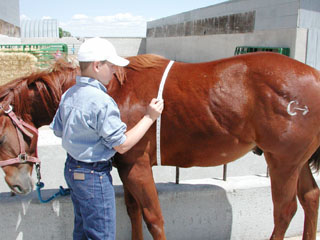
| Figure #1: The girth measurement is taken by placing a tape or thin piece of material around the horse’s girth. The tape encircles the horse just behind the withers on top and just behind the elbows on the bottom. |
Introduction:
There are many reasons why it is important to determine the weight and body condition of a horse. For example, knowing a horse’s body weight is essential to properly dosing medications and supplements. Knowing a horse’s body weight alone, however, cannot indicate if the horse is in proper body condition. This is where body condition scores become necessary. By using both of these pieces of information, a horse owner can provide better care for their animals.Estimating Body Weight: Studies show that even when experienced horse people estimate an animal’s weight by visual inspection alone, significant errors can occur. To help avoid this problem, many horse owners and veterinarians use a heart girth measurement and sometimes a body length measurement to estimate weight. The girth measurement is taken by placing a tape or thin piece of material around the horse’s girth. The tape encircles the horse just behind the withers on top and just behind the elbows on the bottom (see figure #1). The measurement is taken in either inches or centimeters. The length of the horse is also used in some equations. The length is measured from the very front of the shoulder to the very back of the buttocks (see figures #2 and 3). Once these measurements are taken, the following equations can be used:
To determine the horse’s weight in pounds:
Take the [girth (inches) X girth (inches) X the length (inches)] / 330.
To determine the horse’s weight in kilograms:
Take the [girth (cm) X girth (cm) X the length (cm)] / 11,877.
Body weight tapes can also be purchased from local farm stores, but are usually not as accurate.
 |
|
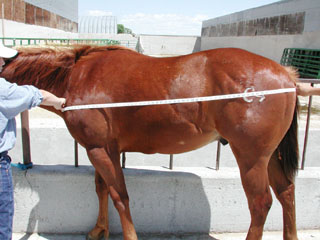 |
|
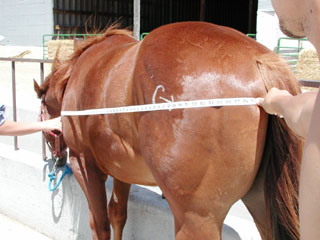 |
|
Body Condition Scoring of Horses
Introduction: Body condition scores are used to identify the general condition of animals. In horses, the grading system is based on the amount of fat found on the animal in certain areas. Each horse is given a body condition score (BCS) that ranges from a 1 (extremely thin/emaciated) to a 9 (extremely fat). Things such as nutrition, reproductive status, weather, parasite load, performance demands, and dental problems can all influence the body condition of horses. Body condition is often a more reliable indicator of the nutritional status than simply using body weights. Realize that horses with the same weight may not have the same BCS.
When assigning a BCS to a horse, begin by stepping back and looking at the horse to observe general fat distribution. Also consider how things such as pregnancy and different amounts of feed in the digestive tract may influence the general appearance of the horse. Then physically feel or palpate the following regions to evaluate the amount of fat deposited in these areas:
A horse with a BCS of 5 should be used as the standard; all other animals should be compared to this "average" horse. A horse with a BCS of 5 is not too fat or too thin; the ribs cannot be seen, but can be felt. Finally, compare results of the visual observations and the manual palpations with the following descriptions adapted from Henneke et al., 1983.
Description of Body Condition Scores (1-9)
1 - Poor: The horse is extremely thin (emaciated). The vertebrae, ribs, tailhead, and hip bones are all prominent. The withers, shoulders, and neck are easily seen. No fatty tissue can be felt.
2 - Very Thin:
This horse is still very thin, but there is a slight fat covering over the base of vertebrae and some parts of the transverse processes of lumbar vertebrae feel rounded. The ribs, tailhead, and hip bones are still prominent. The bone structures of the withers, shoulders, and neck are relatively noticeable.3 - Thin:
This horse has some fat on the backbone and the transverse processes cannot be felt. A slight fat layer covers the ribs, but the ribs are easily identified. The tailhead is prominent, but individual vertebrae cannot be identified visually. The tuber ischii (pins) cannot be seen.4 - Moderately Thin: A ridge along the back and the outline of the ribs can be seen. The tailhead has fat that can be felt around it.
5 - Moderate:
The back is flat with no crease or ridge. The ribs cannot be seen, but are easily felt. The fat around the tailhead begins to feel spongy. The withers appear rounded and the shoulder and neck blend smoothly into the body.6 - Moderately Fleshy:
The horse may have a slight crease down the back, and the fat over ribs and tailhead feels soft and spongy. Small amounts of fat can be found along the side of withers, behind shoulders, and along the side of neck.7 - Fleshy: This horse often has a crease down the back. Individual ribs can be felt, but have plenty of fat between them. The fat around the tailhead is soft. Obvious fat is deposited along the withers, behind shoulders, and along the neck.
8 - Fat:
The crease down the back is obvious and it is difficult to feel the ribs. The fat around tailhead is very soft. The area along the withers and shoulders are filled with fat. Some fat is found along the inner thighs.9 - Extremely Fat:
There is an obvious crease down the back. Patchy fat appears over ribs and bulging fat is found around the tailhead, along withers, behind shoulders, and along the neck. Fat along the inner thighs may rub together and the flank is filled with fat.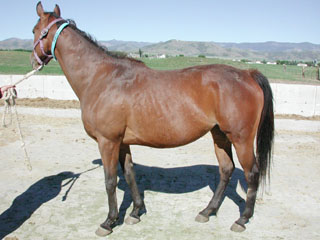 |
BCS of Four
|
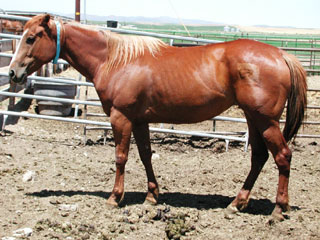 |
BCS of Five
|
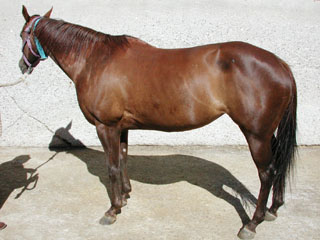 |
BCS of Five
|
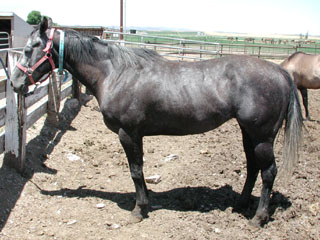 |
BCS of Six
|
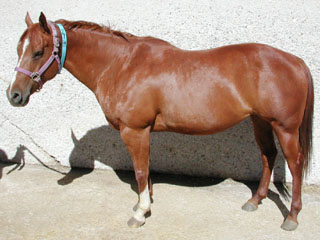 |
BCS of Seven
|
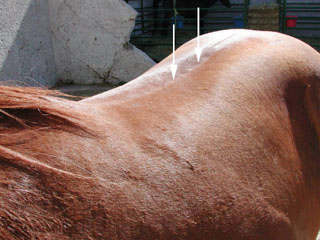 |
BCS of Seven/Eight
|
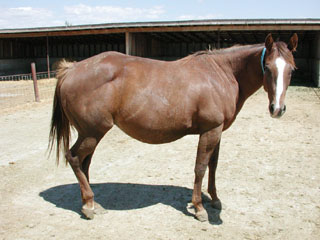 |
|
Summary: Programs should be implemented to help keep a horse at the appropriate weight and body condition score (BCS) for its use and level of activity. For example, a horse that is used for racing and competition should have a body condition score of between a 4-7. Animals just prior to the breeding season and then after becoming pregnant often should have a BCS of 5 or slightly greater. Obese mares may experience difficulty foaling (dystocia), produce less milk, and be more prone to laminitis problems.
It is also important to understand that each individual person may score the same horse differently. This is not a reason for alarm. The key to effectively using body condition scores is to be consistent. Each individual should develop a feel for what each body condition score will look like to them by determining and assigning body condition scores on multiple horses. Then, if changes are noticed in a particular horse’s condition, appropriate adjustments can be made.